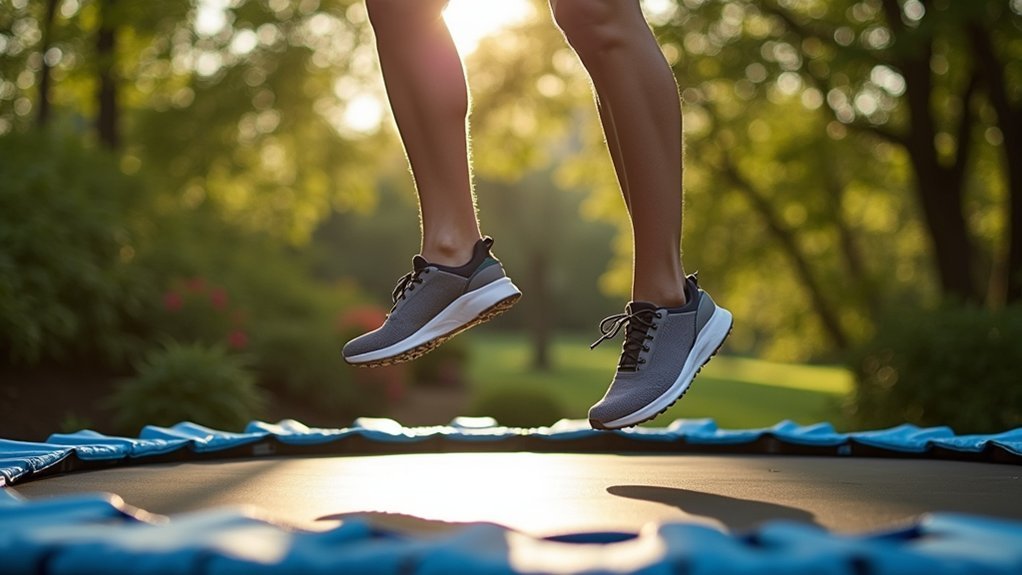Trampolines effectively restore postpartum muscle strength by providing low-impact exercise that activates your pelvic floor and core muscles. The gentle bouncing creates rhythmic contractions that strengthen muscles without strain, while absorbing 80% of impact compared to hard surfaces. You’ll benefit from improved lymphatic circulation, hormonal balance, and mental wellbeing in time-efficient sessions that fit into your busy mom schedule. Discover how this accessible workout can transform your postpartum recovery journey.
The Science Behind Rebounding for New Mothers

While trampolines have gained popularity as a low-impact exercise option, their effectiveness for postpartum muscle recovery remains scientifically unclear. Current evidence doesn’t support trampolines as superior to targeted pelvic floor training for postpartum rehabilitation.
When you bounce, your pelvic floor muscles engage reactively during both takeoff and landing phases. These vertical oscillations create eccentric loading that simultaneously works multiple muscle groups. However, this activation pattern differs considerably from clinical pelvic floor exercises. Many postpartum women should consider consulting a Pelvic Floor Physiotherapist for personalized assessment before starting rebounding exercises.
The timing of when you begin rebounding matters critically. Your body’s early postpartum phase typically benefits more from low-load, controlled movements rather than high-impact activities.
Without proper rehabilitation first, repetitive bouncing might actually exacerbate existing pelvic floor dysfunction through excessive intra-abdominal pressure spikes.
Low-Impact Activation of Postpartum Core Muscles
After childbirth, your core muscles require gentle reintroduction to exercise through low-impact methods that prioritize safety and gradual strengthening.
Deep diaphragmatic breathing serves as your foundation, helping reconnect your brain with abdominal muscles that shifted during pregnancy.
Instead of crunches, which can worsen diastasis recti, focus on transverse abdominis activation through exercises like pelvic bridges and modified planks. These movements strengthen your core without stressing your healing body.
Maintaining proper posture throughout your day provides constant, gentle core engagement.
If you’re dealing with diastasis recti, it’s especially important to avoid forward-flexion movements. It is advisable to wait 4 to 8 weeks for proper recovery before beginning an exercise program. Consult your healthcare provider before starting any routine, and remember that consistent, low-impact exercises yield better results than sporadic intense workouts.
Proper technique matters more than intensity during this rebuilding phase.
Pelvic Floor Recovery Through Gentle Bouncing

Your pelvic floor muscles engage rhythmically during gentle trampoline bouncing, creating a natural pattern of contraction and relaxation.
The gravitational forces experienced while bouncing can help strengthen these muscles as they work against resistance when you land and push off.
This gravity-assisted strengthening offers a functional approach to rebuilding postpartum pelvic floor strength, potentially complementing traditional Kegel exercises.
However, research shows that dedicated pelvic floor muscle training is more effective, reducing urinary incontinence by 37% and pelvic organ prolapse by 56% with moderate certainty of evidence.
Rhythmic Muscle Engagement
Because trampolines create rhythmic movement patterns, they’re uniquely effective for pelvic floor muscle recovery postpartum. When you bounce, your pelvic floor activates with each jump, responding to the gentle mechanical stimulation that engages muscle fibers without overexertion.
Unlike high-impact exercises, trampolines offer controlled oscillation and vibration that specifically target weakened pelvic muscles. You’ll benefit from the repetitive movement that strengthens these muscles gradually while minimizing joint strain—crucial during your recovery period. It’s important to maintain low impact exercises, keeping one foot in contact with the mat to reduce stress on a recovering pelvic floor.
With consistent practice, you’ll notice improvements beyond just pelvic strength. Your balance will enhance, aerobic fitness will increase, and you may experience psychological benefits like reduced stress.
The controlled nature of trampoline exercises allows you to progress at your own pace while effectively rebuilding core stability.
Gravity-Assisted Strengthening
Gravity-assisted strengthening stands as a cornerstone principle in postpartum pelvic floor recovery when using trampolines. The gentle bouncing motion creates controlled gravitational stress that engages your pelvic floor muscles without the harsh impact of activities like running.
This controlled environment allows you to rebuild strength gradually while your body heals. The benefits of trampolining can be enhanced through focused Kegel exercises performed during rest periods to maximize pelvic floor activation.
Your pelvic floor naturally responds to gravitational changes, and trampolines leverage this relationship effectively through:
- Controlled gravitational stress that activates muscle engagement
- Low-impact movement that avoids excessive strain on healing tissues
- Variable resistance as you bounce that promotes neuromuscular control
- Gentle rebounds that create natural activation patterns in pelvic muscles
While research specifically on trampolines for postpartum recovery remains limited, the theoretical benefits align with established principles of progressive, gravity-responsive muscle rehabilitation.
Time-Efficient Workouts for Busy Moms
While juggling the demands of motherhood, finding time for exercise often feels impossible, yet mini trampoline workouts offer an ideal solution for postpartum recovery.
Mini trampolines transform motherhood’s time crunch into opportunity—turning stolen moments into effective postpartum fitness routines.
You’ll maximize limited time with micro-workouts—three 10-minute sessions can fulfill weekly exercise recommendations while fitting into unpredictable schedules.
Portable mini trampolines with handrails let you exercise during naptime or early mornings when your energy peaks. Studies show these workouts help mothers regain strength after childbirth while providing much-needed energy boosts.
Try task stacking: take phone calls while gently bouncing or include your baby by wearing them in a carrier during light rebounds.
High-intensity intervals on your trampoline burn calories efficiently—a 10-minute session can match a 30-minute jog.
Plus, the low-noise models won’t wake sleeping children, allowing you to reclaim evening hours for personal fitness while maintaining household peace.
Progressive Rebounding Exercises for Diastasis Recti

You’ll want to begin with gentle activation movements that engage your deep core muscles without straining the linea alba.
As your strength improves, follow a tension progression protocol that gradually increases resistance while monitoring for any midline doming. Targeted exercises like deep core contractions are essential for recovery, helping to strengthen the transverse abdominis and reduce the inter-recti distance.
Challenge your core stability through controlled rebounding exercises that train functional movement patterns while maintaining proper form and breathing techniques.
Gentle Activation Movements
Postpartum healing requires a thoughtful approach to rebuilding core strength, especially when addressing diastasis recti.
Gentle activation movements provide the perfect foundation for your recovery journey, engaging your transverse abdominis without risking further separation.
These low-impact exercises create a progressive rebounding effect that gradually strengthens your core while protecting your healing muscles:
- Start with gentle pelvic tilts while focusing on your breathing
- Add controlled leg extensions to engage your TVA without strain
- Incorporate small bouncing movements that feel supportive rather than jarring
- Gradually increase intensity as your abdominal wall strengthens
Always watch for signs like doming or pain during exercises as these red flags indicate you need to modify your approach or consult a healthcare provider.
Tension Progression Protocol
The Tension Progression Protocol builds systematically on the foundation of gentle activation movements, creating a structured pathway for diastasis recti recovery through rebounding exercises.
You’ll begin by synchronizing your breathing with pelvic floor activation during mini-bounces. Inhale as you step onto the rebounder, exhale while engaging your transverse abdominis during controlled bounces. Start with just 30-60 seconds to assess your body’s response.
Progress through five distinct phases – from static balance to low-amplitude jumping jacks – only advancing when you’ve mastered each level. Don’t rush this process.
If your diastasis exceeds 2-3 finger-widths or you notice coning, pause rebounding until your TVA strength improves.
Wear compression shorts for additional support and alternate rebounding days with non-impact exercises to build thorough core strength. Always maintain proper posture during each exercise to maximize effectiveness and prevent further separation of the abdominal muscles.
Core Stability Challenges
Building on the foundation of the Tension Progression Protocol, progressive rebounding exercises offer specialized core stability challenges for women recovering from diastasis recti.
These exercises follow a methodical hierarchy that respects your healing journey while gradually increasing demands on your transverse abdominis.
Your rebounding progression should follow this sequence:
- Start seated with simple balance holds to reestablish core awareness without pressure.
- Introduce gentle bouncing with exhale-activated bracing to protect the linea alba.
- Add lateral movements to engage obliques without rotation that could stress your gap.
- Progress to single-leg work only after mastering bilateral stability and confirming gap reduction.
Monitor your progress through regular self-checks, adjusting intensity based on how your body responds while focusing on the transverse abdominal breathing technique that provides stability and mobility to your lower spine.
How Rebounding Accelerates Lymphatic Circulation
Unlike traditional exercise methods, rebounding creates unique gravitational forces that dramatically enhance lymphatic circulation throughout your body. Each bounce triggers alternating weightlessness and 4G landings, forcing lymphatic valves to open and close rapidly.
This vertical motion generates pressure gradients that efficiently pump lymph fluid through nodes and vessels. Even gentle “Health Bounces” for just 2-3 minutes stimulate significant flow, mobilizing immune cells and accelerating toxin removal. The gentle impact on a rebounder significantly reduces joint stress while still providing effective exercise benefits.
For postpartum recovery, rebounding is particularly valuable. It counteracts the hormonal-induced lymphatic stagnation common after childbirth, reduces fluid retention, and aids C-section healing by decreasing nearby swelling.
The heel-to-toe bouncing technique activates calf muscle pumps, enhancing leg lymph circulation—critical for postpartum bodies still clearing pregnancy-related fluids and cellular waste.
Joint-Friendly Movement for Recovering Bodies
While rebounding effectively stimulates your lymphatic system, its joint-protective benefits make it a standout option for postpartum recovery.
Your postpartum body needs exercise that won’t stress already compromised joints. Trampolines offer 80% less joint stress than pavement-based exercises while still mimicking running motions.
Gentle rebounding gives your recovering postpartum body the movement it craves without compromising vulnerable joints.
The shock-absorbing surface creates a perfect environment for rebuilding strength without risking injury.
You’ll experience:
- Gradual load progression that supports weakened joints
- Reduced impact forces on your knees, hips, and pelvic floor
- Safer movement patterns that accommodate healing tissues
- Adjustable intensity that matches your recovery stage
Unlike high-impact workouts, trampolining provides controlled resistance against gravity, allowing you to rebuild proprioception and balance while protecting your healing body. Regular rebounding can also significantly strengthen your pelvic floor muscles, which is essential for preventing postpartum bladder issues.
Balancing Hormones Through Trampoline Exercise
Hormonal fluctuations during the postpartum period can feel like an unpredictable rollercoaster, but trampoline exercise offers a natural path to equilibrium. When you rebound, you’re not just strengthening muscles—you’re activating metabolic processes that help regulate insulin and stabilize blood sugar levels.
The rhythmic bouncing reduces cortisol, your body’s stress hormone, while simultaneously boosting serotonin and dopamine production. You’ll experience improved mood as endorphins flood your system during these enjoyable sessions. Doctors recommend waiting before resuming high-impact activities as your body needs time for pelvic rest after childbirth.
Regular trampoline workouts support your thyroid and adrenal function, which play significant roles in overall hormonal health. The cardiovascular benefits enhance fat oxidation and metabolic efficiency, positively influencing estrogen and progesterone balance.
Building Back Strength: From Gentle to Advanced Rebounding
The journey back to strength after childbirth requires patience and strategic progression, especially when using a trampoline as your recovery tool. Your body needs a gradual approach that respects healing tissues while activating core muscles through gentle movement.
Start with these evidence-based progression steps:
- Begin with seated bounces for 30-60 seconds, allowing your pelvic floor to respond to minimal forces.
- Advance to standing mini-bounces that reflexively engage deep stabilizers.
- Incorporate arm movements to increase intensity once your endurance improves.
- Shift to jogging-in-place motions after confirming pelvic stability.
Mini-trampolines provide greater stability and safety compared to large backyard trampolines, making them ideal for postpartum recovery.
You’ll benefit from the trampoline’s capacity to absorb 80% of impact compared to hard surfaces, making it ideal for reconditioning connective tissues while strengthening bone density through controlled mechanical loading.
The Mental-Physical Connection in Postpartum Rebounding
Many new mothers focus solely on physical recovery after childbirth, yet rebounding exercise creates a unique mind-body synergy that can accelerate healing beyond just muscle repair. The gentle bouncing triggers neurochemical responses that reduce cortisol while increasing mood-boosting endorphins and serotonin. Rebounding is especially helpful for new mothers as it protects joints during the postpartum recovery phase when ligaments are still adjusting.
| Mental Benefit | Physical Connection |
|---|---|
| Reduced anxiety | Rhythmic motion lowers cortisol levels |
| Enhanced focus | Proprioceptive feedback rebuilds body awareness |
| Increased confidence | Micro-goal achievements reinforce self-efficacy |
You’ll find that rebounding creates a meditative state through rhythmic movement, helping quiet intrusive thoughts common in the postpartum period. The playful nature of trampolining also overrides hypervigilance about body changes, while the balance challenges promote neuroplasticity—retraining coordination systems disrupted during pregnancy. This mental-physical connection ultimately transforms exercise from a chore into a healing ritual.
Creating a Sustainable Rebounding Routine at Home
Establishing a consistent rebounding practice requires more than just purchasing a mini-trampoline and placing it in your living room.
Success with rebounding isn’t just about owning equipment—it’s about creating an intentional practice that serves your postpartum body.
You’ll need a strategic approach to guarantee safety, effectiveness, and long-term sustainability in your postpartum fitness journey.
Start by setting up your trampoline on a level surface with ample surrounding space to prevent accidents.
Begin with short 1-2 minute sessions, gradually increasing duration as your strength improves.
To maintain your rebounding routine:
- Schedule specific daily times for trampolining to build consistency
- Set realistic goals that accommodate your energy levels and commitments
- Consciously engage your pelvic floor while maintaining natural breathing
- Track your progress and adjust intensity as needed
Always empty your bladder before each session to minimize the risk of bladder leakage that can occur when rebounding with a weakened pelvic floor.
Remember to stay hydrated and incorporate both warm-up and cool-down periods for maximum benefit.
Frequently Asked Questions
When Is It Safe to Start Rebounding After Giving Birth?
You’ll want to wait at least 6-8 weeks postpartum and get your doctor’s clearance before rebounding. Start only after your core and pelvic floor have healed, typically around 3-6 months post-birth.
Can Rebounding Affect Breastfeeding Milk Production or Quality?
Moderate rebounding won’t negatively affect your milk production or quality. It may actually support breastfeeding by reducing stress and improving your overall health. Just stay hydrated and listen to your body while exercising.
How Does Mini-Trampoline Exercise Compare to Postnatal Yoga?
Both are great postpartum options. You’ll get cardiovascular benefits and muscle strength from mini-trampoline exercises, while yoga offers more flexibility, balance, and mindfulness. Choose based on your preferences or combine them for ideal results.
Are There Specific Rebounding Contraindications for C-Section Deliveries?
After a C-section, you shouldn’t rebound until your doctor approves. Wait until your incision heals, watch for pain, leaking urine, or signs of infection. Diastasis recti can worsen with improper rebounding techniques.
What Trampoline Size and Tension Work Best for Postpartum Recovery?
For postpartum recovery, choose a mini trampoline with moderate, adjustable tension. You’ll reduce injury risk by 6x compared to full-size models while effectively engaging your core muscles and allowing progressive tension increases as you heal.
In Summary
You’ve now discovered why trampolines offer an ideal path to postpartum recovery. By incorporating gentle, progressive rebounding into your routine, you’re activating core muscles, strengthening your pelvic floor, and healing diastasis recti—all while saving precious time. The hormone-balancing benefits and mood-boosting effects create a thorough solution that’s adaptable to your healing journey. Start small, listen to your body, and watch your strength return bounce by bounce.





Leave a Reply